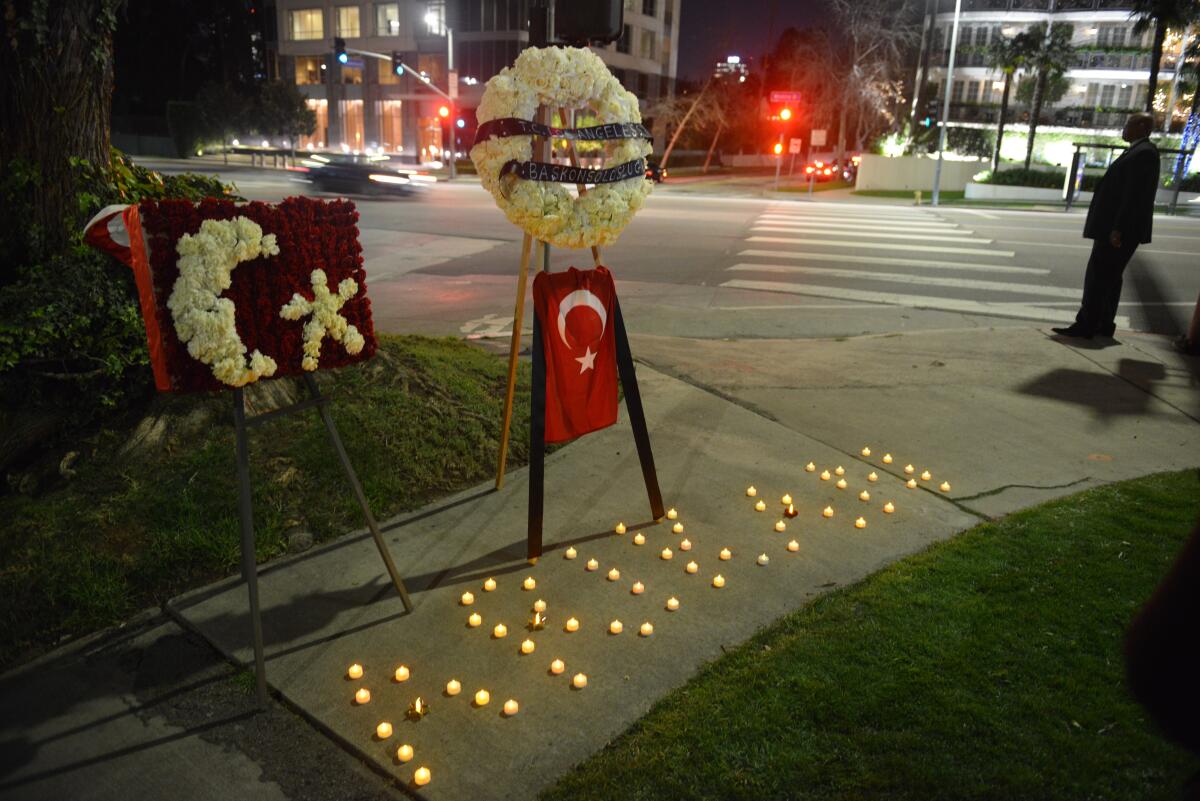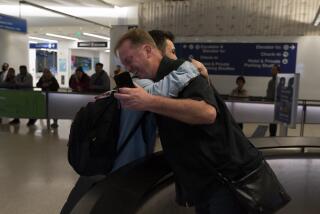After nearly 40 years, man who assassinated Turkish consul in L.A. is getting parole

- Share via
An Armenian American man convicted of killing a Turkish official in Los Angeles in the 1980s will be released into ICE custody after a parole board’s determination that he is not currently dangerous, his attorney said Friday.
Hampig “Harry” Sassounian’s pending release comes after the Los Angeles County Superior Court last month vacated Gov. Gavin Newsom’s decision reversing that parole, and over the objections of the U.S. State Department. For years, lawyers and advocates for Sassounian have argued that he has shown remorse for his crime and that he should be released after serving nearly 40 years in prison.
On Jan. 28, 1982, Sassounian and a crime partner approached Turkish Consul General Kemal Arikan’s car when it stopped at an intersection on the Westside and fired multiple shots, killing the diplomat while he was on his way to work. The pair fled, according to media reports at the time, and Sassounian, then 19, was later apprehended. A jury found him guilty of first-degree murder and found that Sassounian killed Arikan because of his nationality.
The second suspect left the country and was never tried for the crime. A group calling itself the Justice Commandos of the Armenian Genocide called news outlets a few minutes after the assassination to claim responsibility, media reports said. Sassounian denied being a member of that group.
Court records show that Sassounian said that he killed Arikan because he and the other suspect were seeking revenge for the Turkish government’s refusal to acknowledge its role in the Armenian genocide.
In Southern California, home to the largest Armenian community outside of Armenia, news of Sassounian’s impending release set off a communal sigh of relief after years of advocacy on his behalf.
“This is something that everybody rallied around when it happened, and over the last 40 years,” said Nora Hovsepian, chair of the Armenian National Committee of America’s Western region. “Not because anyone condones violence — that’s not the point. .. he did his time. He rehabilitated himself.”
She added: “It’s not the specific act that he engaged in, but it’s an understanding of what led to it. He was so young when he was arrested, and he kind of became a symbol of the ongoing injustice that we as a community continue to suffer at the hands of the Turks.”
Armen Karaoghlanian, 33, of Glendale said that he has been following Sassounian’s case for about a decade, reading the court transcripts and conducting his own research.
For him, Sassounian’s release represents a symbolic triumph for a community that sees itself fighting an “uphill battle” against a nation with greater political and financial clout. Bitter memories of the 1915-1923 massacre carried out by the Ottoman Turks continue to profoundly shape Armenian and Armenian American identity.
As recently as last September, Armenian and Azerbaijani forces began fighting what escalated into a bloody six-week war over a border region known as Nagorno-Karabakh — referred to as the Republic of Artsakh by Armenians. Azerbaijan, supported by its close ally Turkey, recovered significant territory it ceded to Armenia in a previous war over the region that ended in 1994.
The cease-fire brokered in November lingers as a wound for many in the local Armenian community.
“We constantly feel like this underdog trying to fight for what’s right,” Karaoghlanian said. “So I think this is a [win] for us all, because we feel like we finally got something right. And we’re just disappointed that it took so long to get to this point.”
But Sassounian’s upcoming release has provoked outrage in Turkey and among some in the U.S. Turkish community.
Can Oguz, Turkey’s current consul general to Los Angeles, condemned the decision, calling it a dangerous precedent that jeopardizes the security of diplomats around the world.
It’s “based on political considerations, rather than the fundamental principles of the law,” Oguz said by phone. “Hampig Sassounian has shown no remorse for the heinous crime he committed and is not rehabilitated.”
Sassounian’s attorney disputed that claim.
According to a 2020 executive report on parole review decisions from Newsom, the Board of Parole Hearings found Sassounian “suitable for parole, noting that as a child he was subjected to the trauma of war and political strife, that he has participated in self-help programming in prison, he has developed extensive parole plans, he has taken responsibility for the harm that he has caused, he has demonstrated a history of change and increased maturity, and he has given serious thought to how his actions are perceived by others.”
The board also concluded that he possessed the tools necessary to avoid resorting to violence. Sassounian has an active ICE detainer, the report noted, and is subject to deportation if released on parole.
Representatives from the Turkish government expressed their opposition to both state and federal officials, and Oguz said he hopes that federal authorities will intervene to overturn the decision.
Turkey memorialized its “martyred diplomat Kemal Arikan” on the anniversary of the murder earlier this year, and claimed that “Armenian terrorists” have assassinated around 30 Turkish diplomats through the decades all over the world, according to Turkey’s Anadolu news agency.
Arikan “will be remembered with respect as a distinguished diplomat,” Serdar Kilic, who was Turkey’s ambassador to the U.S. until this month, said on the occasion, the news agency said.
A spokesperson for Newsom’s office said that he “has carefully weighed the factors in this case” and that he will not pursue an appeal.
Newsom wrote in his 2020 executive report that he had considered the circumstances that shaped Sassounian’s life when determining whether he should be paroled. The governor pointed to “significant challenges in his family of origin, including the consequences of intergenerational trauma, poverty, and instability resulting from the Armenian genocide in which Mr. Sassounian’s family members were killed.”
After forced deportation from Anatolia, Newsom wrote, Sassounian’s family lived in exile in Lebanon where he “grew up in a war zone and regularly witnessed extreme violence and killings, an experience that had a significant impact on his life.”
In prison, he said, Sassounian participated in self-help programs including substance abuse treatment, nonviolent communication and anger management. He has not, he noted, been disciplined for “serious misconduct” in nearly 20 years.
“I commend Mr. Sassounian for his rehabilitative efforts in prison, but I find they are outweighed by negative factors that show he remains unsuitable for parole at this time,” Newsom said at the time.
Sassounian was granted parole in December 2019, according to the governor’s office, and Newsom reversed the parole grant last May. L.A. County Superior Court Judge William C. Ryan vacated the governor’s reversal in February.
On Thursday, U.S. Secretary of State Antony J. Blinken released a statement saying that the Department of State is “deeply disappointed by the expected grant of parole.”
“Attacking a diplomat is not only a grave crime against a particular individual, it is also an attack on diplomacy itself,” Blinken said. “To ensure the safety of the dedicated U.S. diplomats serving around the world, it has been the long-standing position of the United States to advocate that those who assassinate diplomats receive the maximum sentence possible, and that they serve those sentences without parole or early release.”
Sassounian’s attorney, Susan L. Jordan, said he has been “appropriately punished.”
“Yes, he committed a horrible crime and caused damage, but at end of the day it boils down to whether he’s currently dangerous,” Jordan said. “And if he’s not, when he has served his time, the law says at that point he is ready to be released.”
Times news researcher Julia Franco contributed to this report.
More to Read
Sign up for Essential California
The most important California stories and recommendations in your inbox every morning.
You may occasionally receive promotional content from the Los Angeles Times.













